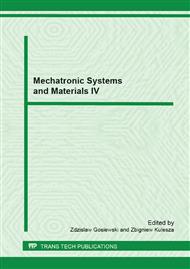[1]
M. Stania, B. Posiadała. Kinematyka prototypowej konstrukcji pojazdu autonomicznego. Mechanik, 12, (2011).
Google Scholar
[2]
R.H. Bishop. Mechatronics an Introduction. University of Texas at Austin, 2006, U.S. A.
Google Scholar
[3]
R. Siegwart, I. Nourbakhsh. Introduction to Autonomous Mobile Robots. Massachusetts Institute of Technology, (2004).
Google Scholar
[4]
S. Lakkad. Modeling and simulation of steering systems for autonomous vehicles". The Florida State University, (2004).
Google Scholar
[5]
M Stania, R. Stetter. Mechatronics Engineering on the Example of a Multipurpose Mobile Robot. Solid State Phenomena Vols. 147-149 (2009) pp.61-66.
DOI: 10.4028/www.scientific.net/ssp.147-149.61
Google Scholar
[6]
L. Ciabanu, N. Thirer, Modeling vehicles and mobile robots. IEEE Xplore, (2009).
Google Scholar
[7]
M. Stania. A mobile platform of an autonomous robot navigating in an unknown.
Google Scholar
[8]
environment. MSc Thesis, Silesian University of Technology, Gliwice, Poland, (2007).
Google Scholar
[9]
M.J. Giergiel, Z. Hendzel, W. Żylski. Modelowanie i sterowanie mobilnych robotów kołowych. PWN, (2002).
Google Scholar
[10]
J. Ota. Multi-agent robot systems as distributed autonomous systems. Advanced Engineering Informatics, Volume: 20, Issue: 1, January, 2006, pp.59-70.
DOI: 10.1016/j.aei.2005.06.002
Google Scholar
[11]
Żylski W. Kinematyka i dynamika mobilnych robotów kołowych, Oficyna Wydawnicza Politechniki Rzeszowskiej, (1996).
Google Scholar
[12]
R. Carelli, G. Forte, L. Canali, V. Mut, G. Araguás. Autonomous and teleoperation control of a mobile robot. Mechatronics, Volume: 18, Issue: 4, May, 2008, pp.187-194.
DOI: 10.1016/j.mechatronics.2008.01.002
Google Scholar
[13]
Giergiel J., Kurc L., Giergiel M.: Mechatroniczne projektowanie robotów inspekcyjnych, Oficyna Wydawnicza Politechniki Rzeszowskiej, Rzeszów (2010).
Google Scholar
[14]
M. Ashmore, N. Barnes. Omni-drive Robot Motion on Curved Paths: The Fastest Path between Two Points Is Not a Straight-Line. Springer-Verlag London, UK 2002, pp.225-236.
DOI: 10.1007/3-540-36187-1_20
Google Scholar
[15]
M. Stania, R. Stetter, A. Paczynski. Lenksystem für Produktionsfahrzeuge auf der Basis von Drehzahl- und Drehmomentdifferenzen. Beitrag zur VDE/VDI-Tagung Elektrisch-mechanische Antriebssysteme (2008).
Google Scholar
[16]
M. Stania, R. Stetter, P. Ziemniak. Intelligentes Steuerungssystem für autonome Fahrzeuge in Service- und Produktionsanwendungen. VDI Wissensforum Mechatronik, (2009).
Google Scholar
[17]
R. Stetter, A. Paczynski, M. Stania, M. Zajac. Autonomes Fahrzeug mit innovativen, patentierten Lenksystem. Elektromobilausstellung, Aschaffenburg, (2008).
Google Scholar
[18]
Patentanmeldung Höhenverstellbares Antriebssystem für mobile Roboter, Aktenzeichen 10 2006 001 055. 8, Deutsches Patent- und Markenamt, München.
Google Scholar


